HOW TO TELL IF A FUNCTION IS LINEAR FROM A TABLE
Subscribe to our ▶️ YouTube channel 🔴 for the latest videos, updates, and tips.
y = mx + b
- y : dependent/responding variable
- x : Dependent/controlled variable
- m : Coefficients (of x) or rate, when x is increasing by 1
- b : y-intercept or starting value (when x is 0, y is___)
Identify if the table is linear or not. If it is, write the equation.
Problem 1 :
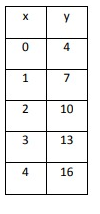
Solution:
In the above table, as x increases by 1, y increases by 3. The rate of change is constant. So, the above table represents a linear function.
Equation:
Let us choose (0, 4) and (1, 7).
Use the slope formula,
Slope-intercept form equation:
y = mx + b
Plug m = 3 and (x, y) = (0, 4)
4 = 3(0) + b
4 = 0 + b
b = 4
Now, plug m = 3 and b = 4 in slope-intercept form equation.
y = mx + b
y = 3x + 4
Problem 2 :
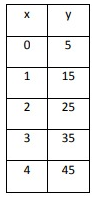
Solution:
In the above table, as x increases by 1, y increases by 10. The rate of change is constant. So, the above table represents a linear function.
Equation:
Let us choose (0, 5) and (1, 15).
Use the slope formula,
Slope-intercept form equation:
y = mx + b
Plug m = 10 and (x, y) = (0, 5)
5 = 10(0) + b
5 = 0 + b
b = 5
Now, plug m = 10 and b = 5 in slope-intercept form equation.
y = mx + b
y = 10x + 5
Problem 3 :
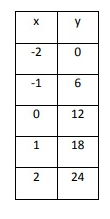
Solution:
In the above table, as x increases by 1, y increases by 6. The rate of change is constant. So, the above table represents a linear function.
Equation:
Let us choose (-2, 0) and (-1, 6).
Use the slope formula,
Slope-intercept form equation:
y = mx + b
Plug m = 6 and (x, y) = (-1, 6)
6 = 6(-1) + b
6 = -6 + b
b = 12
Now, plug m = 6 and b = 12 in slope-intercept form equation.
y = mx + b
y = 6x + 12
Problem 4 :
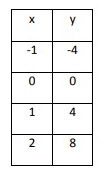
Solution:
In the above table, as x increases by 1, y increases by 4. The rate of change is constant. So, the above table represents a linear function.
Equation:
Let us choose (-1, -4) and (1, 4).
Use the slope formula,
Slope-intercept form equation:
y = mx + b
Plug m = 4 and (x, y) = (-1, -4)
-4 = 4(-1) + b
-4 = -4 + b
b = 0
Now, plug m = 4 and b = 0 in slope-intercept form equation.
y = mx + b
y = 4x + 0
y = 4x
Problem 5 :
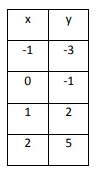
Solution:
In the above table, as x increases by 1, y increases by a greater amount each time. The rate of change is NOT constant. So, the above table represents a nonlinear function.
Problem 6 :

Solution:
In the above table, as x increases by 1,y decreases by 2. The rate of change is constant. So, the above table represents a linear function.
Equation:
Let us choose (-3, 7) and (-2, 5).
Use the slope formula,
Slope-intercept form equation:
y = mx + b
Plug m = -2 and (x, y) = (-3, 7)
7 = -2(-3) + b
7 = 6 + b
b = 1
Now, plug m = -2 and b = 1 in slope-intercept form equation.
y = mx + b
y = -2x + 1
Problem 7 :
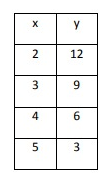
Solution:
In the above table, as x increases by 1, y decreases by 3. The rate of change is constant. So, the above table represents a linear function.
Equation:
Let us choose (2, 12) and (3, 9).
Use the slope formula,
Slope-intercept form equation:
y = mx + b
Plug m = -3 and (x, y) = (2, 12)
12 = -3(2) + b
12 = -6 + b
b = 18
Now, plug m = -3 and b = 18 in slope-intercept form equation.
y = mx + b
y = -3x + 18
Problem 8 :
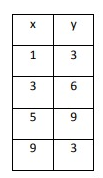
Solution:
In the above table, as x increases by 2, y increases by a greater amount each time. The rate of change is NOT constant. So, the above table represents a nonlinear function.
Subscribe to our ▶️ YouTube channel 🔴 for the latest videos, updates, and tips.
Recent Articles
-
Finding Range of Values Inequality Problems
May 21, 24 08:51 PM
Finding Range of Values Inequality Problems -
Solving Two Step Inequality Word Problems
May 21, 24 08:51 AM
Solving Two Step Inequality Word Problems -
Exponential Function Context and Data Modeling
May 20, 24 10:45 PM
Exponential Function Context and Data Modeling